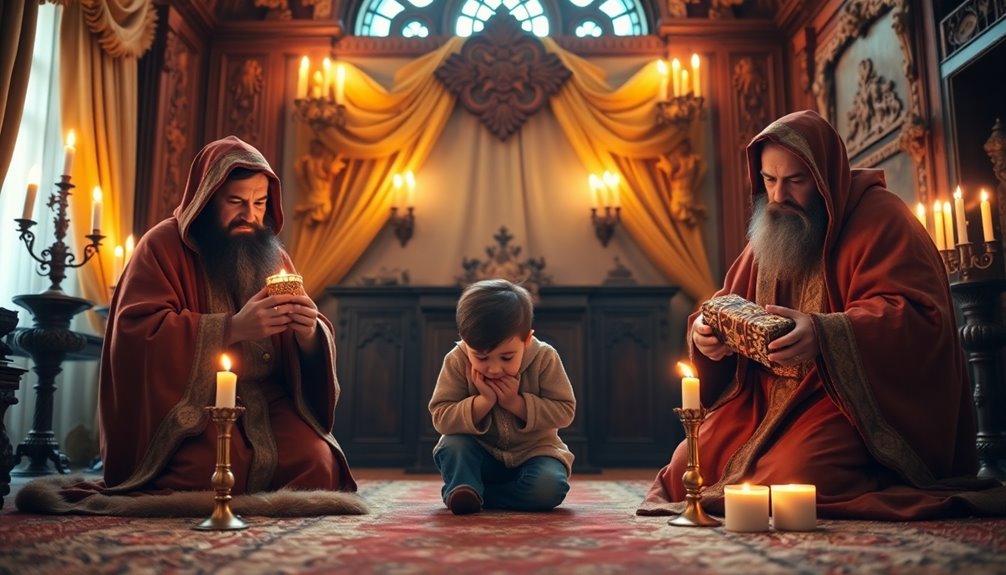Mary was likely around 15 or 16 years old when she had Jesus, which aligns with the common practices of 1st-century Judea. At that time, many girls married young, often between ages 12 and 14. While the Bible doesn't specify her age, early Christian writings suggest she was betrothed around the age of 12. These cultural norms shaped her role and responsibilities as a young mother. Understanding Mary's age provides insight into her life and the expectations of women during that era. If you're curious about the details of her journey and the historical context, there's plenty more to explore!
Key Takeaways
- Historians estimate Mary was around 15 or 16 years old at the time of Jesus' birth.
- Jewish customs allowed girls to be betrothed as young as 12, indicating early marriage norms.
- Typical marriage ages for girls in 1st-century Judea ranged from 12 to 14 years.
- Early Christian writings suggest Mary was about 12 years old when she was betrothed.
- Cultural norms of the time emphasize the expectation of early motherhood and youthfulness in women like Mary.
Introduction

In exploring how old Mary was when she'd Jesus, we delve into a fascinating intersection of history, culture, and religious tradition. You might be surprised to learn that historians estimate Mary was likely around 15 or 16 years old at Jesus' birth. This estimation arises from the prevalent Jewish customs of 1st-century Judea, where young girls were often betrothed as early as 12. Given these cultural norms, Mary, a young virgin, was positioned to fulfill her role as a mother quite early in life.
While the Bible doesn't specify Mary's exact age, various interpretations by scholars suggest she may have been between 12 and 14 years old at the time of Jesus' conception. This context sheds light on the expectations placed on young women during that era, emphasizing early motherhood as a norm.
As you consider these historical insights, it becomes clear that Mary's age isn't just a trivial detail; it reflects broader societal values and practices. Understanding this aspect of her life allows for a deeper appreciation of her significance in religious history and the implications of her unique role in Christianity.
Biblical Insights on Mary's Age

When you look at the Bible, you'll notice it doesn't give a specific age for Mary at Jesus' birth.
Instead, scholars estimate her age based on cultural norms, leaning towards 12 to 16 years old.
Let's explore both primary and secondary biblical references to gain further insights into Mary's age during this significant moment.
Primary Bible References
Numerous biblical insights provide context for understanding Mary's age during Jesus' birth, even if the Scriptures don't specify it directly.
While the Bible doesn't explicitly mention Mary's age, cultural norms and Jewish customs of the 1st century suggest she was likely between 12 and 16 years old. Many historians estimate her age to be around 15 or 16 at the time of Jesus' birth, aligning with the practice of early marriages in ancient societies.
The Gospel of Luke highlights Mary's virginity and divine selection, emphasizing her faith and obedience rather than pinpointing her age. This focus suggests that her youth is secondary to her spiritual significance.
Additionally, early Christian writings like the Protoevangelium of James hint at Mary's youth, with some traditions proposing she was around 12 when betrothed to Joseph.
These biblical references and historical insights indicate that Mary's age was shaped by the cultural framework of her time, reflecting both the customs and societal expectations of young women in ancient Israel.
Ultimately, while we can't pinpoint her exact age, we can glean valuable context from these references that inform our understanding of her life and role in the Nativity story.
Secondary Bible References
Biblical insights shed light on Mary's age during Jesus' birth through various secondary references. While the Bible doesn't specify her exact age, historical estimates suggest she was likely between 12 and 16 years old, with many believing she was around 15.
Jewish culture of that time allowed girls to be betrothed as young as 12, making early marriages common. This context indicates that Mary was probably engaged shortly after reaching puberty.
The Gospel of Luke highlights Mary's humility and faith more than her age, focusing on her response to the angel Gabriel regarding Jesus' conception.
However, early Christian writings like the Protoevangelium of James imply that Mary was about 12 during her betrothal, reinforcing the idea of her youth at Jesus' birth.
Various theological interpretations suggest that Mary's age symbolizes purity and innocence, which align with her vital role in the divine plan of salvation.
Understanding these secondary references helps frame Mary not just as a young mother but as a pivotal figure whose youth plays a significant part in the narrative of Jesus' birth and mission.
Marriage Age in Ancient Judea

In ancient Judea, the marriage age for girls typically ranged from 12 to 14 years, reflecting a cultural norm that prioritized early marriage and motherhood. Jewish customs allowed girls to be betrothed as young as 12, with many marrying shortly after reaching puberty. This societal expectation pushed young women to transition into motherhood quickly, often within a year of betrothal.
Historical estimates suggest that Mary was likely between 12 and 16 years old at the time of Jesus' birth, aligning with these cultural practices. The Mishnah, a significant Jewish text, indicates an expectation for girls to marry by age 12.5, further emphasizing the norm around marriage age in ancient Judea.
As you consider Mary's age, it's essential to recognize that this early marriage age wasn't just a personal choice, but a reflection of the societal structure surrounding her.
Girls were expected to fulfill roles as wives and mothers at a young age, shaping their futures and the dynamics of their families. Understanding these customs provides insight into Mary's life and the context in which she became the mother of Jesus.
Cultural Context of Marriage

Understanding the cultural context of marriage in 1st-century Judea sheds light on the expectations surrounding young women like Mary. In this era, Jewish customs allowed girls to be betrothed as young as 12 years old. This reflects a societal norm where early marriage and motherhood were commonplace. Many girls married shortly after reaching puberty, typically between the ages of 12 and 14, which was seen as a natural progression into adulthood and family life.
The Mishnah indicates that girls were expected to marry by around 12.5 years old, highlighting the societal pressure to conform to these cultural practices. For young women, the expectations weren't just about personal choice but also about fulfilling their roles as wives and mothers.
Mary, likely between 12 and 16 years old when she gave birth to Jesus, exemplifies these norms, as her age aligns with the common practices of the time.
These cultural expectations weren't unique to Judea; various ancient cultures shared similar norms regarding early betrothal and marriage. This widespread expectation profoundly shaped the lives of young women, directing their paths toward family responsibilities at an early age.
Cultural Age Expectations for Women

When you think about the age at which women are expected to marry and have children, it's crucial to understand the historical context.
In 1st-century Judea, societal norms pushed girls into marriage as early as 12, which can seem shocking by today's standards.
Debunking Age Misconceptions
Cultural age expectations for women, particularly in ancient societies, often skew perceptions about figures like Mary. You might assume that Mary's age at Jesus' birth was unusual by today's standards, but historical context reveals otherwise.
In 1st-century Judea, Jewish customs typically allowed girls to be betrothed as young as 12, with many marrying shortly after reaching puberty. This means Mary's age likely ranged from 12 to 16, aligning with cultural practices that prioritized early motherhood.
The Mishnah even indicates that girls were expected to marry by age 12.5, showcasing societal norms that pressured young women into these roles early on. Scholars like Tal Ilan have highlighted that marriages for girls commonly occurred between the ages of 12-14, indicating that Mary fit right within this typical age range.
Understanding these cultural practices helps debunk misconceptions about Mary's age and the expectations placed on young women in her time. Rather than viewing Mary as an anomaly, it's crucial to see her within the context of her society, where early marriage and motherhood were the norm.
Historical Age Discrepancies
The age at which Mary became a mother is often debated, yet it's important to consider how societal norms influenced this aspect of her life. In 1st-century Jewish culture, girls could be betrothed as early as 12, with many marrying shortly thereafter, typically between the ages of 12 and 14.
Historical estimates suggest that Mary was likely around 15 to 16 years old when Jesus was born, which aligns with these cultural expectations for early marriage and motherhood.
The Mishnah indicates that by age 12.5, girls were expected to be married, reflecting significant pressure on young women to fulfill familial roles.
Early Christian traditions, including the Protoevangelium of James, imply that Mary was a young teenager at her betrothal, with some sources suggesting she may have been as young as 12.
Historical and archaeological evidence reinforces the idea that marrying young and having children early were normative practices in ancient Jewish culture.
This context helps you understand how Mary's age was shaped by the customs of her time, revealing a broader view of what it meant to be a woman in her society.
Youthful Resilience in Faith

Mary's unwavering faith at such a young age can truly inspire young mothers today.
Her courage in accepting God's plan, despite potential judgment, shows that resilience in faith can lead to profound impacts.
Mary's Faith Inspires Young Mothers
Inspiring countless young mothers, the story of Mary showcases how faith can carry you through life's challenges, no matter your age. At just 12 to 16 years old, Mary faced societal pressures that could have deterred her. Instead, she embraced her role as the mother of Jesus with remarkable faith, declaring, "I am the Lord's servant." This powerful affirmation highlights her commitment to God's plan, serving as a guiding light for young mothers today.
Mary's journey to visit Elizabeth after the Annunciation further exemplifies her courage and determination. By taking that step, she not only recognized her divinely appointed role but also demonstrated the resilience that young mothers can draw upon. Her story reminds you that even in the face of uncertainty, trusting in God's purpose can lead to profound strength.
As a symbol of purity and innocence, Mary inspires you to remain steadfast in your faith, encouraging you to navigate the complexities of motherhood with grace. Embrace your challenges, just as she did, and allow Mary's faith to remind you that you're never alone on this journey.
Trust in God's plan, and let your faith guide you through every moment.
Support for Young Mothers
Countless young mothers find themselves navigating the complexities of motherhood with strength and resilience, often drawing inspiration from figures like Mary. At around 15-16 years old when she'd Jesus, Mary's story reflects the cultural norms of her time, where early marriage and motherhood were the societal expectations.
This historical context allows young mothers today to recognize that they're not alone in their journeys.
Embracing motherhood at a young age can feel daunting, especially with the weight of societal pressures. However, Mary's acceptance of her divine calling demonstrates that youthful resilience can lead to profound faith experiences. The bond between a father and daughter can also provide essential support during these times, highlighting the importance of mutual respect and understanding.
By looking to her example, young mothers can find empowerment in their own paths, reminding themselves that they, too, can rise above expectations.
Support systems are essential for young mothers. Connecting with faith communities, seeking mentorship, or finding peer support can help you navigate the challenges of early motherhood.
Remember, like Mary, you can embrace your journey with courage, and your faith can guide you through the complexities of motherhood.
You're part of a larger narrative, one that celebrates the strength found in youthful resilience and the beauty of your unique journey.
Mary's Age: A Cultural Insight

In the context of 1st-century Judea, young women often faced societal pressure to marry and start families shortly after reaching puberty. Historians estimate that Mary was likely between 12 and 16 years old when she gave birth to Jesus, with many suggesting her age was around 15 or 16. These ages reflect the cultural practices of early marriage prevalent during that time.
Jewish customs permitted girls to be betrothed as early as 12, which meant that early motherhood wasn't just common, but expected. The Protoevangelium of James hints that Mary was around 12 at her betrothal to Joseph, illustrating the norm of marrying young.
This cultural expectation placed significant pressure on young women like Mary, compelling them to embrace their roles as wives and mothers soon after reaching puberty. The lack of specific details about Mary's age in biblical texts has led to various interpretations over the years.
However, many traditions support the notion of her being a young teenager when she gave birth, emphasizing how deeply ingrained these cultural practices of early marriage were in their society.
Additional Resources

For those interested in exploring the topic of Mary's age further, a variety of resources are available that delve into historical, cultural, and theological perspectives.
To understand Mary's age at the time of Jesus' birth, you might start by examining scholarly articles that discuss Jewish customs surrounding marriage and motherhood in 1st-century Judea. These resources typically highlight how girls could be betrothed as young as 12, which was common during that era.
You can also look at early Christian writings, such as the Protoevangelium of James, which suggest that Mary was around 12 at her betrothal. This text, while not part of the canonical Bible, provides insights into the cultural norms of the time.
Additionally, books focused on the cultural context of the New Testament can offer you a deeper understanding of why Mary's age is often speculated to be between 12 and 16 years old.
Engaging with these materials will give you a well-rounded view of how historical and cultural contexts shaped the narratives surrounding Mary and her role in Jesus' birth.
Frequently Asked Questions
How Old Was Mary When She Conceived of Jesus?
You might be curious about Mary's age when she conceived Jesus.
Historians generally estimate she was between 12 and 16 years old, with 15 being the most common suggestion.
During that time, it was typical for girls to be betrothed as early as 12, reflecting societal norms around early marriage and motherhood.
While the Bible doesn't specify her exact age, cultural practices give us a clearer picture of her likely age during this pivotal moment.
How Old Was Mary When She Gave Birth to Jesus JW?
You might wonder about Mary's age when she gave birth to Jesus.
Most scholars estimate she was between 12 and 16 years old, reflecting the cultural norms of 1st-century Judea. In that era, girls often married and had children young, with betrothal starting around age 12.
While the Bible doesn't specify her exact age, early Christian traditions suggest she was likely in her early teenage years when she gave birth.
What Was the Age of Mary When She Married Joseph?
When you consider the age of Mary when she married Joseph, historical estimates suggest she was likely around 13 to 14 years old.
Jewish customs of the time allowed girls to be betrothed as early as 12, reflecting societal norms in 1st-century Judea.
Early sources like the Protoevangelium of James indicate she was betrothed by age 12, aligning with the expectation for girls to marry shortly thereafter.
What Was the Age Gap Between Mary and Joseph?
When you consider the age gap between Mary and Joseph, it's important to note that historical estimates suggest Joseph was in his late teens to early twenties, while Mary was around 12 to 16 years old.
This creates a significant age difference, reflecting the societal norms of their time.
You'll find that early marriages were common, with girls often betrothed as teenagers, while men typically married a bit later.










